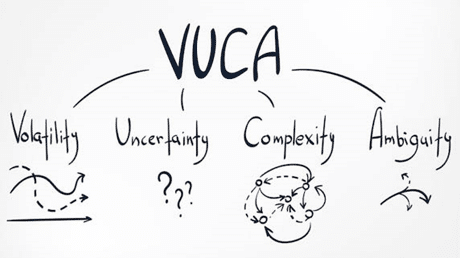Leading in a VUCA World

Today, we are operating in a complex and chaotic environment that requires leaders to stay agile, seek out data and experiment with options. Further understanding of this environment can be explained by the VUCA (Volatile, Uncertain, Complex, and Ambiguous) model[1]. Within the model, leaders can further find clarity in the types of activities they can be taking. We’re seeing many of these leadership behaviors in action during the pandemic.
- Volatile: Unstable and changing
- Leader’s role: Emphasize agility, utilize resources strategically
- Example: As the virus started to quickly spread throughout China, hospitals were built almost overnight to accommodate patient needs. The government quickly gathered personal protective equipment and ventilators to meet the needs of medical providers and citizens.
- Uncertain: Not clear what impact events will have
- Leader’s role: Seek information, expand information networks
- Example: In the early days of the virus, it was unclear how and to what extent the U.S. would be impacted. The WHO and CDC sought out information about the virus, collected morbidity and mortality data from other countries, and built global communication networks to understand the virus as much as possible.
- Complex: High number of interconnected moving parts
- Leader’s role: Mirror the environment
- Example: State-level leaders are mirroring advice from across the seas as there have been an overwhelming number of interconnected issues such as lack of supplies, increased virus transmission, and failing economies. Ohio’s governor started acting, seeking information, and mirroring Europe’s call to action before a single case of COVID-19 was documented in the U.S.
- Ambiguity: No precedent. Cause-and-effect and basic rules of the game not known
- Leader’s role: Explore options, experiment
- Example: Scientists throughout the world are working to develop vaccines to prevent transmission and medications to treat the virus in critically ill patients.
As you lead your team’s through these volatile and uncertain times, think about how you are responding to the environment around you and what you could be leveraging from the VUCA model to best support your team.
CMA continues to wish everyone happiness and safety during this difficult time.

[1] U.S. Army Heritage and Education Center (February 16, 2018). “Who first originated the term VUCA (Volatility, Uncertainty, Complexity and Ambiguity)?”. USAHEC Ask Us a Question. The United States Army War College. Retrieved July 10, 2018.
